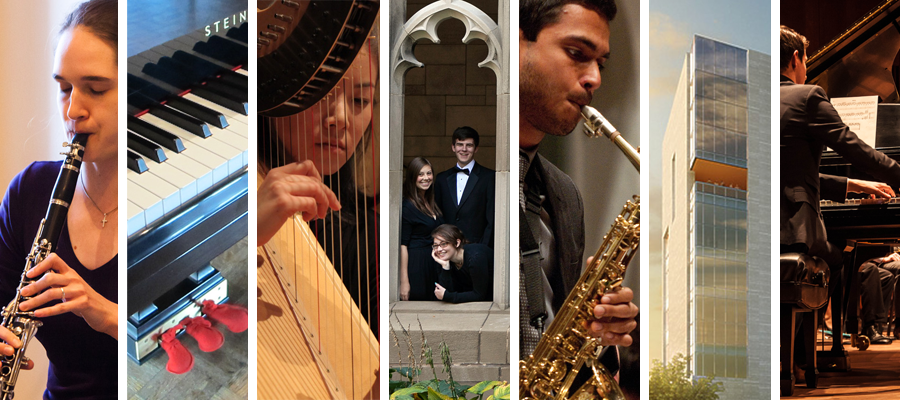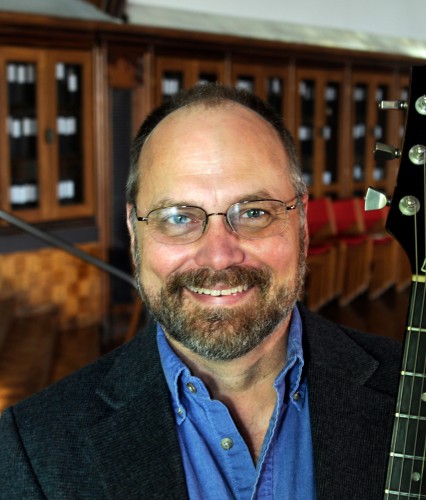Lawrence Zbikowski, Associate Professor of Music and the Humanities in the College and Chair of the Department of Music, discusses the Logan Center for the Arts performance spaces. He will present a pre-concert talk on legendary guitarist Jimi Hendrix at the University of Chicago Presents Special Logan Launch Festival event featuring the Turtle Island Quartet on Sunday, October 14 beginning at 2 PM in the Performance Hall.
With the addition of the Logan Center and its three new state-of-the-art performance spaces, I gather that there are number of ensembles that will perform at our other wonderful locations such as Fulton Recital Hall and Mandel Hall. So how do the ensembles and their performance spaces relate to each other?
One of the things that will happen with the Logan Center and the [Performance Hall] there in particular is that we now have a recital hall that is going to have some very fine acoustics. And we’ll have a seating capacity and also in some ways a hall capacity (I’ll come back to that in a moment) but a seating capacity that really fits quite a few of the events that will happen on campus. It’s always wonderful to look at a big hall like the Symphony Center downtown and say, ‘Wow! Wouldn’t it be great to fill this?’ But let’s face it. Not every event is going to fill that. But more importantly, acoustically, you don’t always want to have an ensemble or production or performance that will find its happiest home within that large space. Sometimes you want a more intimate space because you have an instrument or ensemble that has a more intimate sound.
And so I think the new [Performance Hall] is going to be ideal for more of a recital kind of event. And that gets back to the sort of volume… When I heard the Pacifica Quartet perform there in June of this year, one of the things that struck me about the hall is that at that point it was still just a little bit dry, but I felt that the overall volume of the hall in terms of the cubic feet of air there was really appropriate for that kind of ensemble. Because as a musician, what you have to do is that you have to push sound through the air. And anybody who’s ever taken their beautiful, wonderful sounding instrument outside has found a very disappointing result because you are not getting anything back from the instrument at that point. And my sense is that the [Performance Hall] – they’ve really done a very good job matching the overall size of the hall in terms of the volume with the kinds of performances that will be featured there. Kirkegaard was doing some additional work on the acoustics and I think they’re going to make it just a little bit more live that it was. And so my sense is that this is going to be a perfect venue for things like the Wind Ensemble and also for Chamber Orchestra – groups like that, which could play in Mandel Hall, but I think that much of the nuance and interesting things that those musicians can do will come out in a slightly smaller space.
Fulton Hall is going to continue to be a great place for recitals but Fulton’s capacity is closer to around 150 – it’s a marvelous, intimate space. As a classical guitarist, I love playing in Fulton because the sound is good. But that’s really a place where you can – the guitar sound doesn’t get lost no matter where you’re sitting in the room. Fulton is great for that. It’s also very good for our New Music Ensemble, which consists of smaller groups, but also sounds that really range – everything from ppp (pianississimo) up to fff (fortississimo). So I think that that’s going to be an ideal place for new music and also will be the continuing venue for our Noontime Concerts Series. Those are typically soloists or relatively small ensembles. For a somewhat intimate performance, then I think that’s going to be a great place. The other thing is that the new [Performance Hall] is wonderful but it doesn’t have 4th to 5th floor – looking out over Quads and seeing this sunlight or evening light come in. And so there’s that special space there.
Of course, one place in the Logan that does have some of that [light] is the Performance Penthouse up on the 9th Floor. And I have a feeling that that’s going to be a really interesting place for some innovative performances. I was just talking to David Douglass of the Newberry Consort and he’s thinking about having their group perform there in October because that’s going to be a place where not only is the music they’re doing intimate, but they can also explore different ways of seating themselves in respect to the audience. So if you want a venue where you don’t necessarily have the stage there and the seats over there, the Performance Penthouse, I think, will give very interesting opportunities for moving musicians around relative to the audiences.
And then finally, Mandel Hall is still going to be our biggest seating venue. And so for the largest concerts — that the University of Chicago Presents puts on but also for the Symphony Orchestra concerts — that is going to be the ideal place for that sort of event to happen. So I think that between Mandel, Fulton, and the performance spaces in Logan, what we’ll have is an even better match between ensemble and event and performance space.
I also understand that there are a number of new classrooms in the Logan Center. How will the new building impact academics in the department?
I think again, one of the things that will be very interesting to see what happens as we work with the Logan Center staff in terms of programming this space. I have a feeling that those classrooms are going to get booked up fairly soon. But what it also means is that some of those classrooms are going to be next to classrooms or work areas that are being occupied by other people in the arts. And so I think one of the really interesting things that may happen will be more cross-pollination among the arts. And it may not always happen that students literally walk out of one classroom and into another but to simply be around artists as they’re working, to see what sort of things they’re doing, to walk by a room and see their art spread out on the floor or up on the walls, is I think a very good thing to do and avoid the kind of insularity that can happen in any of the arts. That insularity is necessary because you need to focus on what you’re doing and if you keep yourself open to absolutely everything you get absolutely nothing done. But at the same time, getting a little bit of the cross-pollination going on, can be very useful for artists even if they don’t try to incorporate it into what they are doing themselves, they see the broader perspective of how art functions within contemporary culture.
Interview by Julia Tobiska, Performance Program Assistant

